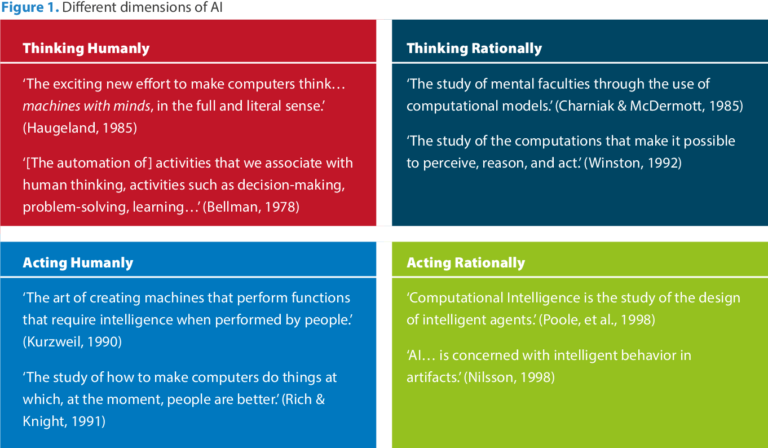How To Use AI To Make Better Decisions

In an ever-evolving digital landscape, harnessing the power of Artificial Intelligence (AI) has become crucial for making informed decisions. From assisting individuals in their daily lives to transforming industries across the board, AI holds the potential to revolutionize how we navigate the complexities of decision-making. This article will explore practical strategies for effectively incorporating AI into your decision-making process, empowering you to leverage this cutting-edge technology to make better choices in any aspect of your life. So, get ready to unlock the potential of AI and take control of your decision-making prowess!

Understanding AI
What is AI?
AI, or Artificial Intelligence, is a branch of computer science that focuses on creating intelligent machines that can mimic human intelligence. It involves developing systems and algorithms that can perform tasks that typically require human intelligence, such as problem-solving, learning, and decision-making. AI has the ability to analyze vast amounts of data, recognize patterns, and make predictions, enabling it to provide valuable insights and facilitate decision-making processes.
Types of AI
There are three main types of AI: narrow AI, general AI, and superintelligent AI. Narrow AI refers to AI systems that are designed to perform specific tasks with a high level of competence, such as image recognition or natural language processing. General AI, on the other hand, refers to AI systems that possess the ability to understand, learn, and apply knowledge across different domains, similar to human intelligence. Lastly, superintelligent AI refers to AI systems that surpass human intelligence in almost every aspect and have the potential for self-improvement.
Benefits of AI
AI offers numerous benefits in decision-making processes. Firstly, AI can analyze large datasets quickly and accurately, providing insights that humans may miss. It can identify patterns, trends, and correlations that can lead to more informed and effective decision-making. Additionally, AI can automate repetitive and mundane tasks, freeing up human time and resources for more complex and strategic decision-making. AI also has the potential to reduce human biases and errors by making decisions based on objective data and algorithms. Overall, AI has the potential to enhance decision-making processes across various industries and sectors.
Preparing for Decision-Making with AI
Identify the Decision-Making Process
Before implementing AI in decision-making, it is essential to identify and understand the existing decision-making process. This involves mapping out the steps involved, the roles and responsibilities of individuals, and the inputs and outputs of each stage. By having a clear understanding of the decision-making process, you can effectively integrate AI in a way that complements and enhances the existing workflow.
Define the Problem
Defining the problem is crucial in decision-making, as it sets the foundation for the AI system to address. Clearly articulating the problem statement helps in identifying the relevant data, selecting appropriate AI models, and determining the desired outcomes. This step ensures that the AI system focuses on the right aspects and provides relevant solutions.
Gather Relevant Data
To make informed decisions using AI, it is essential to gather relevant data that can help in addressing the problem at hand. This can involve collecting data from various sources, including internal databases, external databases, or publicly available datasets. The data should be representative of the problem and be of high quality to ensure accurate analysis and modeling.
Using AI for Data Analysis
Data Cleaning and Preprocessing
Before analyzing the data, it is crucial to clean and preprocess it to ensure its quality and usability. This involves removing any duplicates, outliers, or irrelevant data points. Data preprocessing may also include standardizing or normalizing the data, converting categorical variables into numerical representations, and handling missing values. By cleaning and preprocessing the data, AI models can work with accurate and reliable data.
Exploratory Data Analysis
Exploratory Data Analysis (EDA) involves analyzing and visualizing the data to gain insights and understand its characteristics. EDA techniques such as data visualization, summary statistics, and correlation analysis can help uncover patterns, relationships, and anomalies within the data. This step allows decision-makers to gain a deeper understanding of the data and identify potential areas of focus for further analysis.
Data Modeling and Algorithms
Once the data has been cleaned and analyzed, AI models and algorithms can be applied to make predictions and provide insights. This involves selecting appropriate algorithms based on the problem statement and the type of data. Machine learning algorithms, such as regression, classification, or clustering, can be used to build predictive models or identify patterns within the data. By leveraging AI models, decision-makers can gain valuable insights that aid in making informed and data-driven decisions.

Implementing AI Decision-Making Models
Choosing the Right Model
When implementing AI decision-making models, it is crucial to choose the right model that best suits the problem at hand. There are various AI models available, ranging from simple to complex, and each model has its strengths and limitations. Decision-makers should consider factors such as the type of data, the desired outcomes, and the level of interpretability when selecting the appropriate model.
Training and Testing the Model
Once the model has been selected, it needs to be trained using relevant and representative data. During the training process, the model learns to recognize and generalize patterns from the data. After training, the model should be tested using a separate dataset to assess its accuracy, performance, and generalizability. This step ensures that the model is reliable and can provide accurate predictions or recommendations.
Evaluating Model Performance
Evaluating the performance of the AI model is crucial to ensure its effectiveness and reliability. Various metrics, such as accuracy, precision, recall, or F1 score, can be used to assess the model’s performance. Decision-makers should also consider the model’s interpretability, scalability, and computational requirements when evaluating its suitability for decision-making. Regular monitoring and evaluation of the model’s performance are necessary to identify any potential issues or areas of improvement.
Interpreting AI Decisions
Interpretable AI Techniques
Interpreting AI decisions is essential to understand the underlying reasoning and factors considered by the AI system. Interpretable AI techniques aim to make AI models more transparent and understandable to decision-makers and stakeholders. Techniques such as feature importance analysis, visualizations, or rule extraction can help in interpreting and explaining the decision-making process of AI models.
Ensuring Fairness and Ethics
AI decision-making should be guided by fairness and ethics to prevent biases and discrimination. Decision-makers should ensure that the AI models are trained on diverse and representative datasets to avoid skewed or unfair outcomes. Regular audits and assessments can help identify and address any biases that may arise from the AI system. It is important to establish ethical guidelines and frameworks that govern the use of AI in decision-making to ensure fairness and accountability.
Human Oversight and Validation
While AI can enhance decision-making processes, human oversight and validation are paramount. Human experts should review and validate the decisions made by AI systems to ensure their accuracy, relevance, and alignment with organizational goals. Humans can provide contextual knowledge, domain expertise, and critical thinking abilities that complement the capabilities of AI. By combining human judgment with AI insights, decision-makers can make well-informed and responsible decisions.
Ethical Considerations in AI Decision-Making
Bias and Discrimination
Bias and discrimination are significant ethical concerns in AI decision-making. AI systems can inadvertently perpetuate biases present in the data used for training, resulting in biased outcomes and discrimination. Decision-makers should be vigilant and proactive in identifying and addressing biases to ensure fair and unbiased decision-making. Regular data audits, diverse data representation, and ongoing monitoring can help mitigate the risk of bias and discrimination.
Transparency and Accountability
Transparency and accountability are essential elements of ethical AI decision-making. Decision-makers should ensure that AI systems and their decision-making processes are transparent and explainable. Clear documentation, traceability, and auditability of AI models can promote transparency and enable external scrutiny. Additionally, decision-makers should establish mechanisms to be accountable for the decisions made by AI systems and be prepared to take responsibility for any unintended consequences.
Privacy and Security
Privacy and security considerations are critical when using AI for decision-making. Decision-makers must ensure that the data used for training and decision-making is handled securely and in compliance with applicable data protection regulations. Data anonymization, encryption, access controls, and monitoring can help safeguard data privacy and protect against unauthorized access or breaches. Privacy impact assessments and security audits should be conducted to identify and mitigate potential risks.
Overcoming Challenges in AI Decision-Making
Data Quality and Availability
One of the significant challenges in AI decision-making is ensuring high-quality data and its availability. Decision-makers should invest in data cleansing techniques, data validation processes, and data governance frameworks to maintain data quality. Collaboration with relevant stakeholders and partnerships with data providers can help access diverse and reliable datasets. Additionally, decision-makers should address any data gaps or limitations through data augmentation or research partnerships.
Algorithmic Bias and Error
Algorithmic bias and error can arise when AI models are trained on biased or incomplete datasets. Decision-makers should implement thorough validation and testing procedures to uncover any biases or errors in the AI decision-making process. Techniques such as fairness metrics, bias detection algorithms, and diversity-aware training can be employed to reduce algorithmic bias and error. Critical evaluation and refinement of AI models are necessary to ensure fairness, accuracy, and reliability.
Human-Machine Collaboration
Balancing the roles of AI systems and human decision-makers is a challenge in AI decision-making. Decision-makers should foster a collaborative environment where human experts and AI systems work together in a symbiotic manner. Human judgment, creativity, and ethics can be coupled with AI’s analytical capabilities to make well-informed decisions. Effective communication, training, and ongoing collaboration can facilitate human-machine collaboration and address potential challenges.
AI Tools for Decision-Making
Natural Language Processing
Natural Language Processing (NLP) tools enable AI systems to understand and process human language. NLP can be used in decision-making processes to extract insights from textual data, analyze customer feedback, automate document processing, and facilitate communication between humans and machines. NLP tools can enhance the efficiency and accuracy of decision-making by enabling AI systems to understand and interpret textual information.
Machine Learning Platforms
Machine learning platforms provide a set of tools and frameworks for developing and deploying AI models. These platforms offer pre-built algorithms, data preprocessing capabilities, model training, and evaluation tools, making it easier for decision-makers to implement AI in decision-making processes. Machine learning platforms can streamline the development and deployment of AI models, allowing decision-makers to focus on the problem-solving aspects.
Predictive Analytics Tools
Predictive analytics tools leverage AI and statistical techniques to make predictions and generate insights from data. These tools can be used to forecast future outcomes, identify trends, segment customers, optimize resource allocation, and assess risks. Predictive analytics tools enable decision-makers to make data-driven decisions by providing them with actionable insights and recommendations based on historical data.
Case Studies: AI-Driven Decision-Making
Finance and Investment
In the finance and investment industry, AI-driven decision-making has become increasingly prevalent. AI models can analyze vast amounts of financial data, detect patterns, and make predictions about market trends and investment opportunities. This can help financial institutions in portfolio optimization, risk assessment, fraud detection, and algorithmic trading. AI-driven decision-making in finance can lead to more accurate and informed investment strategies, ultimately benefiting investors and financial institutions.
Healthcare and Medicine
AI has the potential to revolutionize decision-making in healthcare and medicine. AI models can analyze medical images, genomic data, electronic health records, and patient data to aid in diagnosis, treatment planning, and drug discovery. AI-driven decision-making can assist healthcare professionals in making faster and more accurate diagnoses, personalized treatment recommendations, and predicting patient outcomes. This can improve patient care, reduce medical errors, and ultimately save lives.
Customer Relationship Management
AI-driven decision-making can greatly enhance customer relationship management (CRM) strategies. AI models can analyze customer data, behavioral patterns, and preferences to segment customers, personalize marketing campaigns, and optimize customer experiences. By leveraging AI insights, businesses can make data-driven decisions to enhance customer satisfaction, improve sales and marketing strategies, and drive customer loyalty. AI-driven decision-making in CRM can help businesses gain a competitive edge and build long-lasting customer relationships.
Conclusion and Takeaways
Harnessing the Power of AI
AI has the potential to revolutionize decision-making processes across various industries and sectors. By harnessing the power of AI, decision-makers can analyze vast amounts of data, make accurate predictions, and gain valuable insights that can inform and guide their decision-making. AI can enhance efficiency, effectiveness, and accuracy in decision-making, enabling organizations to make well-informed and data-driven choices.
Continuous Learning and Adaptation
AI is a rapidly evolving field, and decision-makers should embrace continuous learning and adaptation. They should stay updated with the latest AI technologies, trends, and best practices to effectively leverage AI in decision-making processes. Ongoing evaluation and refinement of AI models, along with regular monitoring and feedback, are necessary to ensure their relevance and effectiveness. By adapting to the evolving AI landscape, decision-makers can maximize the benefits of AI in decision-making.






